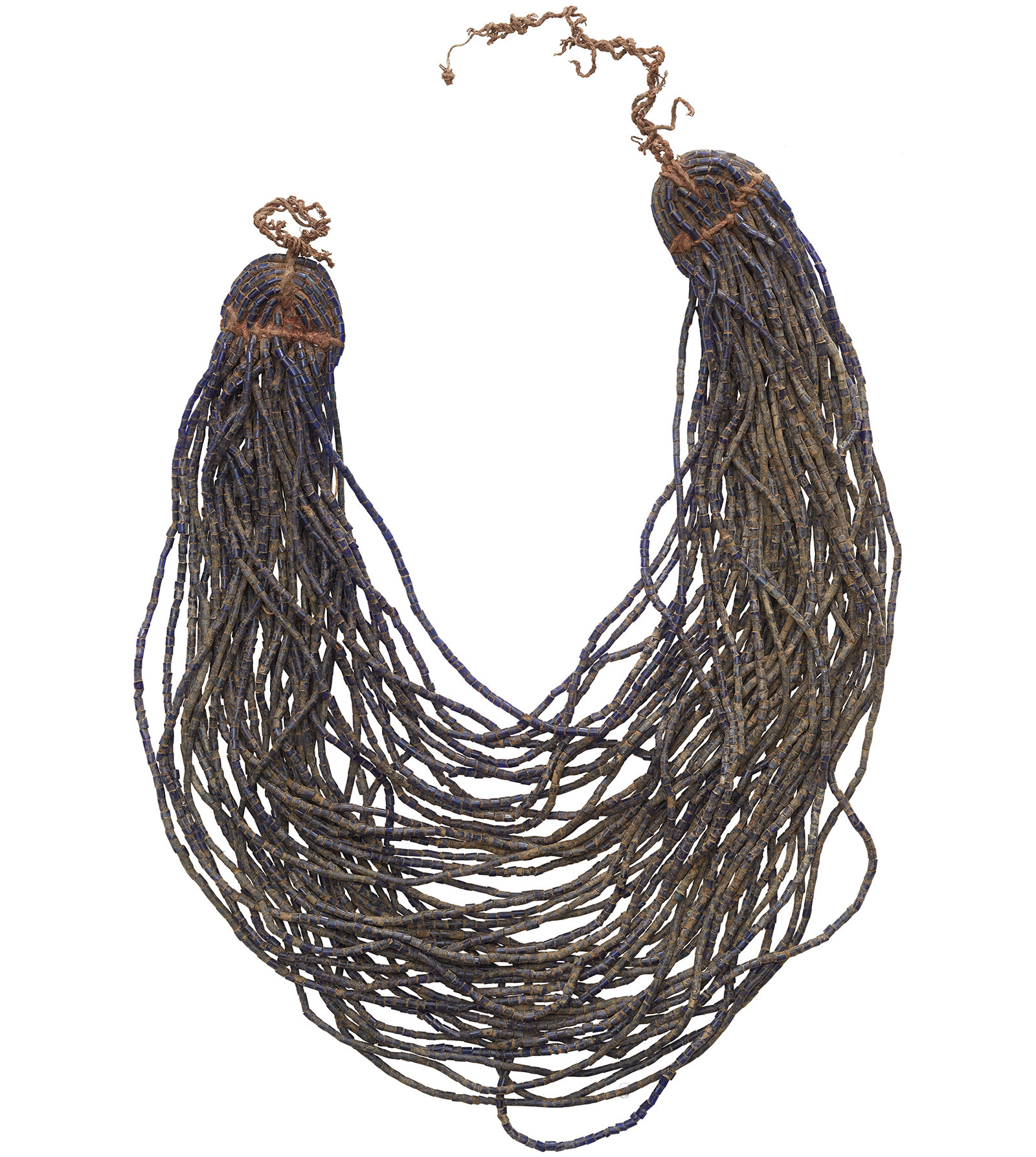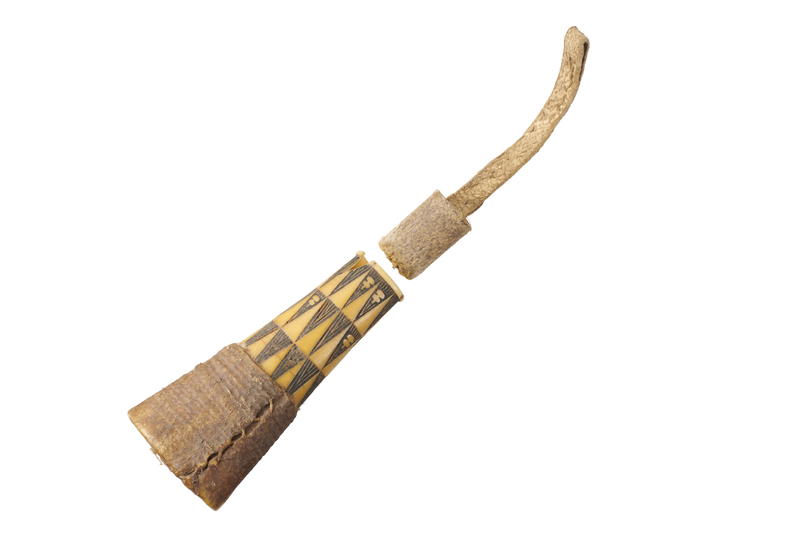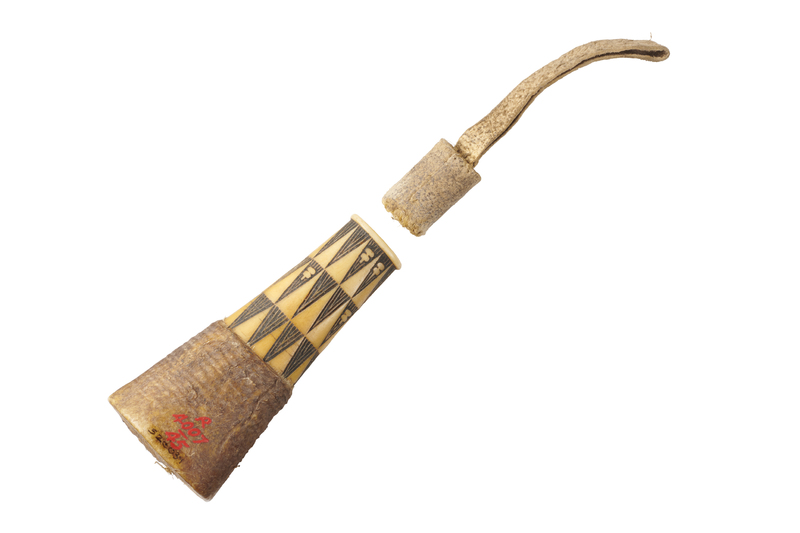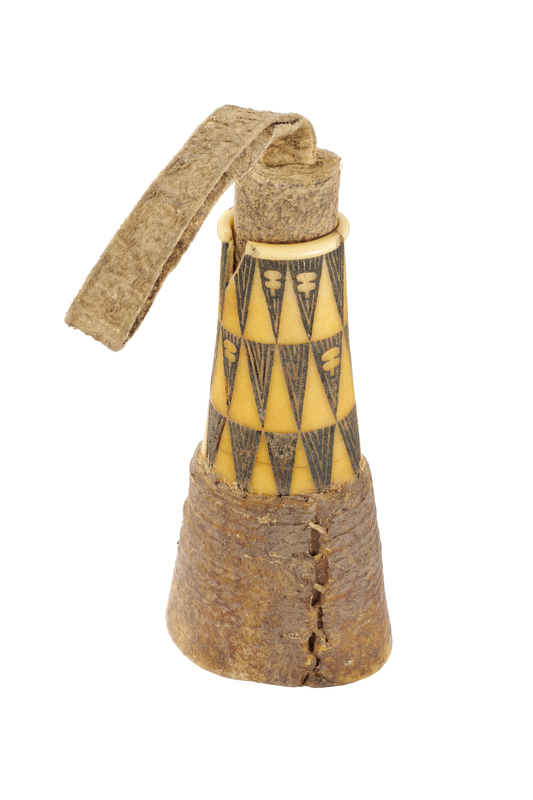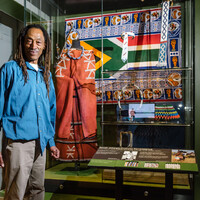Snuff Container; Nakana
Item
Title
Snuff Container; Nakana
Creator
Unrecorded
Description
Physical Description: Ivory & animal hide small snuffbox, conical shape with three rows of downward facing chevron / triangle like incised decoration. Eight of these chevron motifs, four on upper row, four on middle row, also have a club like addition in the shape of a figure eight with a protruding stem. Hide stopper with leather thong loop.
Contextual Description: ivory tusk. Notes from Tshepo Skwambane and Neil Parsons initial visit to view objects, 2017
Contextual Description: 01:53:02 He says the common material here for snuff boxes was like, cow horn or one from a wildebeest. Transcription by KL of MAC_BB_20190817_RPM3 SL Interview with Tshupo Ntono, Village Elder, Language: Setswana with English translations by SL, 2019
Contextual Description: SL 29:24
See, the original material for making snuff boxes was a horn, cut it at the end - a cows horn and like I was saying nakana means a small or baby horn.
JM 29:40
But this one's ivory. Yeah.
SL 29:42
So now later on any snuff container would be described as nakana and even even if it's some plastic that contains some ointment that you bought from the from the pharmacy. You still will still use the same term to describe it.
SL 31:41
later in the years when people were using like plastic containers now as their snuff boxes. No snuff consumer would love to have a Nakama made out of plastic which is like transparent. They always like to be the opaque one because they say It doesn't show how much snuff you have. So if someone is asking for [some snuff, you say] it's just empty no definitely like that, but if it's transparent we'll see how much snuff you have.
WT 32:15
People who never used to like buying for themselves. They'll just say oh can you 'kgeipile' meaning ... what is 'kgeipa'? [SL: You are craving] Can you...you give them and later [they say it again]...you know so that's why they wanted to conceal the amount that they had because you can't be supporting this guy everyday.
NS 32:41
do people still use the snuff or is it not as popular
SL 32:45
When I was growing up it was it was a granny and granddad thing. Okay old people, okay and they will be the ones hitting those grinding stones and dealing with those and even knowing which wood to use, they'll favour the likes of Mopane, Motshwere, to put all the ashes to get to their snuff. Nowadays snuff is sold ready made in a shop... the yellow plastic containers. It it's divas who are doing it man. It's like young beautiful ladies and that they have all kinds of reasons
GK 33:27
claim to lose some blood pressure.
WT 33:30
But in South Africa its worse you know that yeah.
WT 33:33
I want to go to...
SL 33:38
you see a lady going for her handbag and then taking out the makeup kit and then checking No, no it's not and then she goes it fishes out her snuff container.
WT 33:49
And then this lecturer has taken the covers for the snuff the green things and its there in the earrings. The earrings are like that. The green cover for the snuff
WT 34:08
They've just been pricked and and they've hooked and it's earrings.
GK 34:11
OK So they do take snuff
WT 34:14
I think they do, but they're even appreciating that so much that even put it into in the earrings
SL 34:21
I saw an [eco tech?] show on YouTube, in Europe and they were using a ram's horn as a snuff container. So they have nakana too!
The above notes are from a transcription by Kathleen Lawther of a discussion between Gase Kediseng, JoAnn McGregor, Nicola Stylianou, Scobie Lekhuthile and Winani Thebele which took place at the Khama III Memorial Museum on the 5th of August 2019. To listen to the full recording please follow the link below.
See, the original material for making snuff boxes was a horn, cut it at the end - a cows horn and like I was saying nakana means a small or baby horn.
JM 29:40
But this one's ivory. Yeah.
SL 29:42
So now later on any snuff container would be described as nakana and even even if it's some plastic that contains some ointment that you bought from the from the pharmacy. You still will still use the same term to describe it.
SL 31:41
later in the years when people were using like plastic containers now as their snuff boxes. No snuff consumer would love to have a Nakama made out of plastic which is like transparent. They always like to be the opaque one because they say It doesn't show how much snuff you have. So if someone is asking for [some snuff, you say] it's just empty no definitely like that, but if it's transparent we'll see how much snuff you have.
WT 32:15
People who never used to like buying for themselves. They'll just say oh can you 'kgeipile' meaning ... what is 'kgeipa'? [SL: You are craving] Can you...you give them and later [they say it again]...you know so that's why they wanted to conceal the amount that they had because you can't be supporting this guy everyday.
NS 32:41
do people still use the snuff or is it not as popular
SL 32:45
When I was growing up it was it was a granny and granddad thing. Okay old people, okay and they will be the ones hitting those grinding stones and dealing with those and even knowing which wood to use, they'll favour the likes of Mopane, Motshwere, to put all the ashes to get to their snuff. Nowadays snuff is sold ready made in a shop... the yellow plastic containers. It it's divas who are doing it man. It's like young beautiful ladies and that they have all kinds of reasons
GK 33:27
claim to lose some blood pressure.
WT 33:30
But in South Africa its worse you know that yeah.
WT 33:33
I want to go to...
SL 33:38
you see a lady going for her handbag and then taking out the makeup kit and then checking No, no it's not and then she goes it fishes out her snuff container.
WT 33:49
And then this lecturer has taken the covers for the snuff the green things and its there in the earrings. The earrings are like that. The green cover for the snuff
WT 34:08
They've just been pricked and and they've hooked and it's earrings.
GK 34:11
OK So they do take snuff
WT 34:14
I think they do, but they're even appreciating that so much that even put it into in the earrings
SL 34:21
I saw an [eco tech?] show on YouTube, in Europe and they were using a ram's horn as a snuff container. So they have nakana too!
The above notes are from a transcription by Kathleen Lawther of a discussion between Gase Kediseng, JoAnn McGregor, Nicola Stylianou, Scobie Lekhuthile and Winani Thebele which took place at the Khama III Memorial Museum on the 5th of August 2019. To listen to the full recording please follow the link below.
Publisher
Making African Connections
Date
Pre 1899
Type
PhysicalObject
Format
Whole: 170 mm x 40 mm x 26 mm
Animal hair; Animal ivory; Ivory; Leather; Hide
Identifier
R4007/45
Source
Collected by Reverend William Charles Willoughby, a Christian missionary, in what was then the Bechuanaland Protectorate (1885-1966). It is now the Republic of Botswana, having gained independence from Britain in 1966.
From 1889-92 Willoughby was pastor at Union Street Church, Brighton (now The Font pub). From 1893 to 1898 he worked for the London Missionary Society in Bechuanaland. He assembled this collection of objects during this period. This was a period of social and technological changes and these objects represent traditional lifestyles and skills, rather than the contemporary lives of the people Willoughby met.
Willoughby's collection was loaned to Brighton Museum in 1899 when he returned to the UK. The loan was converted into a donation in 1936, and accessioned as acquisition R4007.
Some objects were re-numbered with the WA (World Art) numbering system in the 2000s. These numbers have been reverted to the original R4007/... numbers where possible for consistency in 2019.
From 1889-92 Willoughby was pastor at Union Street Church, Brighton (now The Font pub). From 1893 to 1898 he worked for the London Missionary Society in Bechuanaland. He assembled this collection of objects during this period. This was a period of social and technological changes and these objects represent traditional lifestyles and skills, rather than the contemporary lives of the people Willoughby met.
Willoughby's collection was loaned to Brighton Museum in 1899 when he returned to the UK. The loan was converted into a donation in 1936, and accessioned as acquisition R4007.
Some objects were re-numbered with the WA (World Art) numbering system in the 2000s. These numbers have been reverted to the original R4007/... numbers where possible for consistency in 2019.
William Charles Willoughby
Botswana, Southern Africa, Africa
1893-1898
Space/Place
Botswana, Southern Africa, Africa
Cultural Group: Tswana
Rights
Creative Commons Attribution-ShareAlike 4.0 International
Item sets
Linked resources
Filter by property
| Title | Alternate label | Class |
|---|---|---|
 Snuff Snuff |

